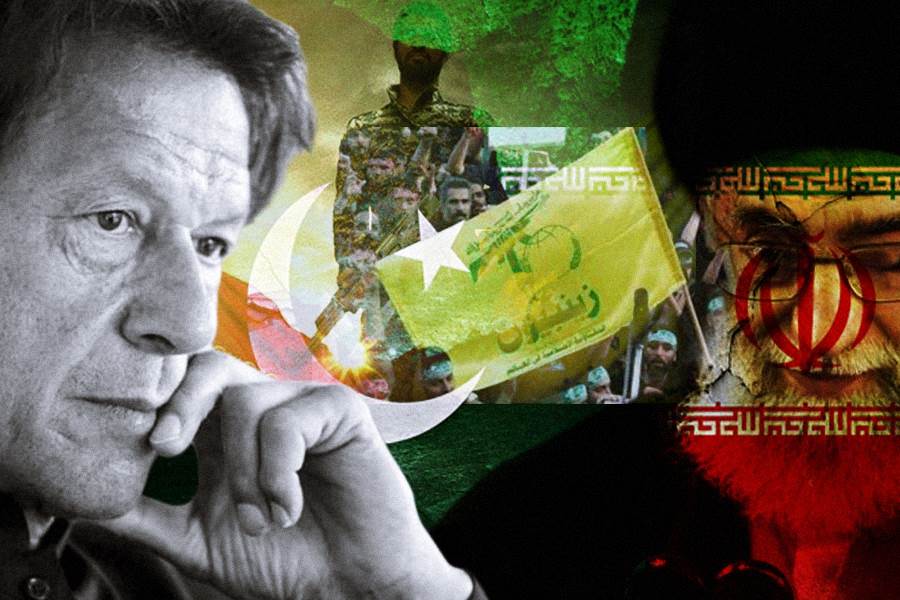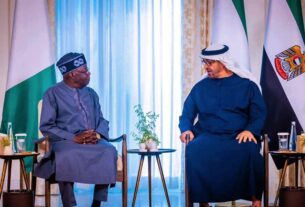Sat 07 October 2020:
Could it be a wake-up call for Pakistan that battle-hardened militants trained by Iranian Revolutionary Guards and Quds force might be returning to Pakistan as Iran’s pawns?
Iran, in an effort to develop strict security policies as the events that broke out in Tunisia at the end of 2010 spread across the Middle East in a short time, not only increased its influence in countries with a predominantly Shi’a population but also its leverage on determining the fate of conflicts in Syria and Yemen that Iranian-backed groups were involved in.
After the Assad regime suffered heavy losses against opponents, Iran became directly involved in the Syrian civil war under the guise of protecting sites considered sacred in Shiism. But, on suffering heavy casualties and receiving scathing criticisms, Tehran created many mercenary groups through the Iranian Revolutionary Guards Corps (IRGC) and Quds Forces.

These groups include the Fatemiyoun Brigade, which is reputed to have a large number of fighters recruited from among Afghani Shi’as, and the Zainabiyoun Brigade, designated as a striking force, whose membership is estimated at somewhere between two and five thousand, consisting of Pakistani Shias.
The Revolutionary Guards first invited the Lebanese Hezbollah to Syria in 2012. Later, approximately 15 groups, including those comprised of Afghan and Pakistani Shias, were armed and immediately dispatched to the battleground. These groups had a strong impact on the current state of the Syrian civil war and the Assad regime’s gaining the upper hand.
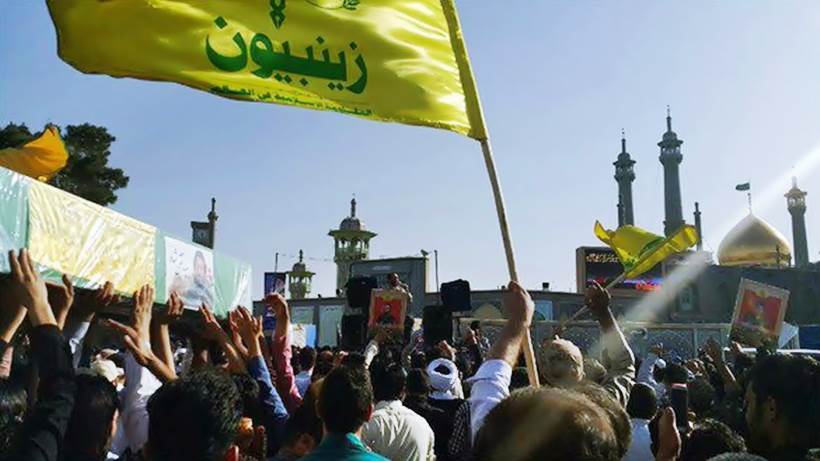
Two Pakistanis who were killed in Syria reportedly fighting for the IRGC’s Zainabiyoun Brigade are buried in Qom, Iran, May 18. Pakistan is taking measures to counter Iran’s recruitment of Pakistani Shias to fight in its proxy wars, officials say. [WarReports]
So far, everything seems normal in the context of Iran’s Shia-oriented policies. However, the need for these armed groups is gradually decreasing, with the real issue now becoming what will eventually become of them. One of these recruited-mercenary groups organized by the Iranian Revolutionary Guards, the Zainabiyoun Brigade is of particular concern in this regard, as members of this armed group, with a lot of fighting experience, are likely to pose a threat to Pakistan’s national security in the future.
Pakistan and sectarian issues
The Shia-Sunni conflict in Pakistan is almost sure to flare up every year in the month of Muharram [the first month of the Islamic lunar calendar in which the heartrending Karbala Massacre took place in the year 680 AH]. This flaring up is usually the result of either an attack in areas with a large Shia population or provocative comments or statements made by Shiite clerics.
Last Muharram, a Shia cleric using provocative and insulting language on a TV program about the first three caliphs of Prophet Muhammad (the three who preceded Ali, the first Shia imam) once again ratcheted up the tension in Pakistan. A series of brawls between the Shia and Sunni groups in the country ensured the spread of the video footage of the cleric’s provocative comments on social media.
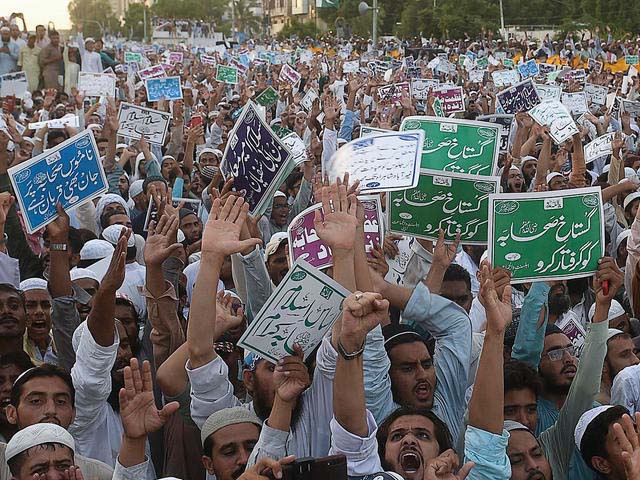
Sunni Muslim demonstrators shout slogans in Karachi, during protest against provocative and insulting language against the first three caliphs. PHOTO: AFP
With a large number of precedents in the past, this constant friction begs the question of whether a sectarian conflict might occur in Pakistan large enough to endanger its internal security and trigger instability in the country. This religious fanaticism and the sectarian elements in Pakistan can be safely traced back to the Iranian Revolution in 1979. Right after the revolution, the Shiites in the Pakistani town of Bakkar established a movement to implement the Ja’fari interpretation of Islamic Law.
The leader of this group was Arif Hussain al-Hussaini, a student of the Iranian Revolution leader, Ayatollah Khomeini. Supported by Iran, al-Hussaini tried to create a sphere of influence capitalizing on the networks he was affiliated with in Pakistan as well as the favorable circumstances and the overall ideological atmosphere engendered by the Iranian Revolution.

Protesters gathered in Karachi and Islamabad for an anti-America rally in the wake of the killing of Iran’s Maj Gen Qasem Soleimani in a US drone strike. Photo-AP
In Pakistani madrasahs, al-Hussaini used a curriculum that was pursuing a policy in favor of the Iranian Revolution and directing their youth to go to Iran to receive all kinds of education. Al-Hussaini was also trying to lead the efforts to import Iran’s revolutionary ideology into Pakistan. His efforts took on a different dimension with the establishment of the Zainabiyoun Brigade.
Years of training and the networks forged paid off, and Iran started to recruit militants from Pakistan very easily. Therefore, the efforts of al-Hussaini began to be seen as elemental in the forming of the Zainabiyoun Brigade, which has been used by Iran in the Syrian civil war.
However, it is not surprising that Pakistani Shia militants are used in Syria as fighters. Although approximately 80 to 85 % of the population in Pakistan are Sunnis, who adhere to various Sunni Islamic schools of thought (Deobandis, Barelvis, Sufis and Salafis/Wahhabis), Iran-backed Shia organizations also wield significant influence.
Pakistan has been a scene of sectarian violence between Sunnis and Shias — in which Iran is also thought to have a hand — since a number of incidents first occurred between two communities in 1986. It is stated that in the nearly three thousand sectarian attacks that have taken place to date, around 10 thousand have lost their lives.
The Zainabiyoun Brigade
The Zainabiyoun Brigade, which came to the forefront due to the high casualties they suffered in the UAV and armed UAV attacks carried out by the Turkish Armed Forces in the Idlib operation, is a terrorist group consisting of Pakistani Shiites, based mostly around Aleppo and Damascus.
It was revealed that the Pakistani Shia militias, who previously acted individually, were organized under the name ‘Zainabiyoun Brigade’ in 2014 following a missile attack by the Salafi militias on the Shrine of Sayyida Zaynab in Damascus in 2012. According to the Tehran administration, protecting the Shrine of Sayyida Zaynab against attacks is the main reason this group is in Syria.
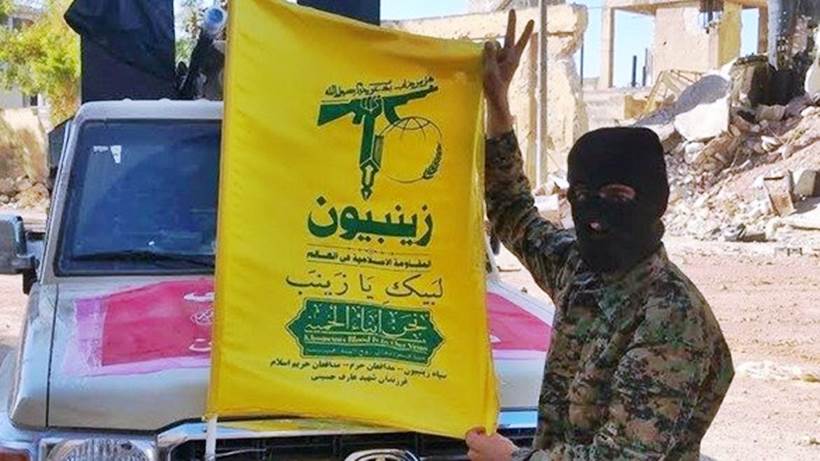
A Zainabiyoun Brigade fighter holds a banner that reads ‘Zainabiyoun, the brigade is made up of Pakistani Shia, recruited by Iran’s Islamic Revolutionary Guard Corps, who are fighting alongside the Syrian regime. [Photo from Zainabiyoun supporters’ social media accounts]
The group, which got its name from Prophet Mohammad’s cousin and son-in-law Ali’s daughter Zaynab, — as previously noted — consists of Pakistani Shiites recruited by Iran with various promises. The members of this group are much more educated than other Iranian-backed organizations. The majority of them are students coming from Pakistan to Iran for education or “pilgrims” who come to perform Shiite rituals.
Al-Mustafa International University, located in the city of Qom in Iran, is one of the most important recruitment centers where a lot of Pakistani students join the ranks of the Zainabiyoun Brigade.
Although the group currently has an estimated number of between two to five thousand militants, Pakistani intelligence officials state that the group’s actual number of fighters recruited from Pakistan could be much higher. The majority of the members of the Zainabiyoun Brigade come from the Shia-dominated Parachinar in the Kurram district of the Federally Administered Tribal Area (FATA), where Pakistan’s government control is weak. The employers of Pakistani fighters in Syria are the Iranian Revolutionary Guards and the Quds Force, which, needless to say, support the Syrian regime.
Iran’s main tools: Poverty and ideology
Looking at the studies, poverty and ideological motivations seem to be the main reasons for fighting on Iran’s side. While Iran promises jobs and an income, especially to the poor Shiite population that took refuge in this country, it also abuses faith as a tool of sectarian-ideological exploitation.
The Shia propaganda made by Iran to increase enlistment in the Zaynabiyyoun Brigade for ideological reasons has significant influence. By laying emphasis on the religious shrines and graves targeted and desacralized by Daesh, especially in the civil war, Iran also arouses hatred against the Sunni groups fighting on the side of the opposition in Syria and persuades people to fight voluntarily in the name of protecting Shiite values.
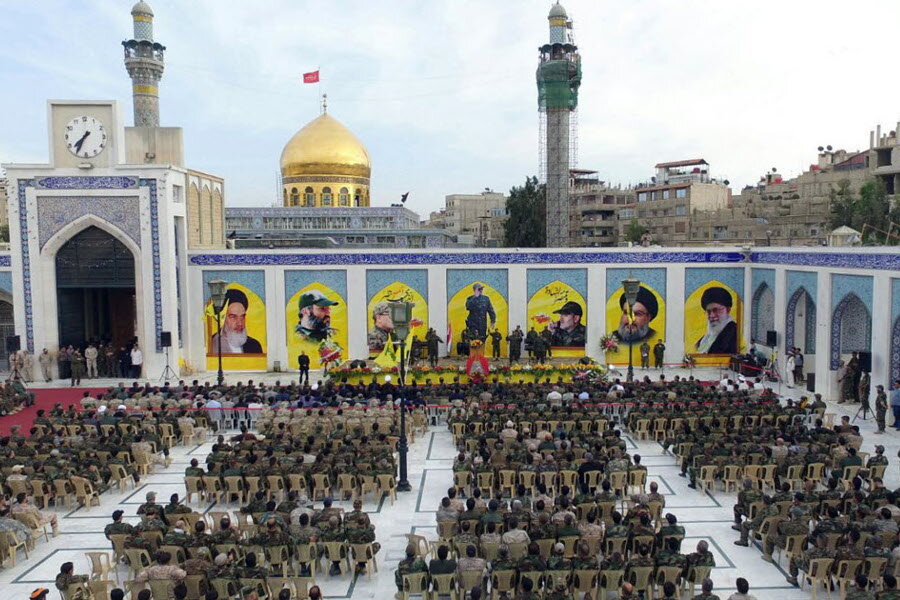
Iranian back militia attend a funeral at the shrine of Sayyida Zeinab, in a suburb of Damascus, Syria, May 17, 2016. Saturday’s bombing took place near the shrine, one of the most renowned in Shiite Islam.
Realizing that using such tactics makes it easier to influence the Shia youth who are generally more prone to fall prey to ideology, Tehran uses all kinds of propaganda to recruit Shiite militia. The promise that those who die in the war will be regarded as martyrs and be buried in Iran’s holy city of Qom is also used as an ideological tool.
Another trump card of Iran is its ability to turn poverty into an opportunity. The poor among the Shia who took refuge in Iran are offered citizenship, jobs and a steady income for themselves and their families, and thus feel obliged to agree to fight on conditions that Iran imposes. Otherwise, they face deportation. Pakistani fighters are offered an average monthly salary of around 120,000 rupees ($ 700-750) in return for fighting under given conditions, and are even promised 15-day holidays after three months.
All kinds of training, and any essential needs, of the militias who have been persuaded to fight are organized and met by the Quds Force, which operates under direct orders from the Revolutionary Guards.
In response to the establishment of the Zainabiyoun Brigade, anti-Shia attacks began to occur in Pakistan. For example, at the end of 2015, more than 20 people lost their lives and many were injured in an explosion that took place in the center of Parachinar, where the Shiite community in the Kurram district of the Federally Administered Tribal Area constitute the majority.
Lashkar-e-Jhangvi, a violent anti-Shia group, claimed responsibility for the attack. Ali Abu Sufyan, the spokesperson of the group, said that the purpose of the attack was “to take revenge for the crimes Iran and Assad committed against Syrian Muslims” and added that he had warned the people of Parachinar to stop going to Iran to join the ranks of Assad and also stop sending militants there.
And after this attack, many others have taken place in cities with a predominantly Shia population, in addition to ongoing efforts to spread the clashes, which mostly take place every year in the month of Muharram, throughout the country.
Militant groups and Pakistan’s national security
The dynamics in Syria have changed rapidly in recent times and the need for terror groups formed of recruited mercenaries has also decreased. This situation creates uncertainties about the fate of the Zainabiyoun Brigade and how Iran is likely to position itself with regard to it. Pakistani intelligence service has noted time and again that the number of fighters who fought in Syria at one time and returned to Pakistan is high, and that some among them tried to enter the country illegally.
The main problem stems from Pakistan’s failure to put in place the necessary measures up to this point. The question of what will happen when these militants return to Pakistan is one that perturbs security experts. Could it be a wake-up call for Pakistan that battle-hardened militants trained by the Iranian Revolutionary Guards and the Quds Force might actually be returning to Pakistan as Iran’s pawns?
Apart from the security problems they will cause for Pakistan in the future, the group’s presence has already become a big bone of contention in Pakistan. If we need to list the dangers that these militants may pose; primarily these people can have an ideological influence on the youth. These militants, who will somehow return to Pakistan, will represent Iran’s “supply chain”, so to speak, and network in the region.

The second danger is that these militants will be able to reopen Pakistan’s sensitive sectarian wounds when they are instructed to do so and trigger instability in the region. In this way, Tehran will be able to interfere in Pakistan’s internal affairs whenever it feels is necessary and continue the proxy game in the region.
Islamabad, on the other hand, behaving very negligently in this regard, neither banned groups and organizations calling on young Pakistanis to join the Zainabiyoun Brigade, nor developed a strict policy with regard to Tehran’s use of Pakistan as some kind of supply warehouse of militants.
Although it is known that Iran recruits militants from Pakistan, the Islamabad administration’s unwillingness to officially react to the situation concerns security experts. This attitude of Pakistan boils down to a number of hard facts on the ground. The first is the fact that Pakistan has long been in an economic strain. Pakistan, which normally sides with Saudi Arabia mainly for economic reasons, feels cornered due to the deterioration of relations with Riyadh recently.
This being the case, it is highly likely that Islamabad wants to avoid doing any harm to its relations with Iran by openly speaking against the Zaynabiyoun Brigade. The second is that Islamabad would hate to see Iran slipping into the Indian axis in the event it caused a deterioration in its relations with Tehran. For this reason, it is avoiding any statements about this issue at a diplomatic level for the time being.
But as time wears on, Islamabad’s overlooking the developments and not taking measures in due time carries the risk of further increasing sectarian tensions that often cause violence in the country.
According to Pakistani security experts, it is clear that Iran has an undeniable role in the events taking place in Pakistan. According to them, Iran’s role cannot be denied either in the case of Kulbhushan Yadav, who is said to be a soldier in the Indian Navy and a spy of the Indian Intelligence captured on the Pakistan-Iran border, or in the case of the fleeing of Uzayr Baluj (a national of both Pakistan and Iran, who assassinated many people and is also involved in many organized crimes) to Iran over the Chabahar Port during the operation Pakistan launched to capture him.
In addition, while all this is happening, the fact that the Zainabiyoun Brigade has not been criticized seriously in the Pakistani media is very conspicuous. Since no official statement has come from the government to date, the Pakistani media also avoids taking up the issue. However, if the citizens of a country, which is vulnerable to sectarian conflicts, are assigned by another country to fight in its name, the media has a responsibility to keep this issue on the agenda and to investigate it in the contexts of security and society.
Moreover, it is a fact that Iran has not fully used its influence in Pakistan in sectarian conflicts up until today. With the withdrawal of the US forces from Afghanistan, however, it is predicted that Iran will come to have the influence to an extent that can threaten the regional balances. An alarming situation that vindicates these predictions is that after the killing of Qasim Suleimani, Ismail Ghani was appointed as the new commander of the Quds Force, a division primarily responsible for extraterritorial military operations.
Before becoming the head of the Quds force, Ghani was closely involved in recruiting militants from Pakistan and Afghanistan, as well as their transport to Iran and training. The fact that Ghani has wide networks in the region and knows the region very well is an issue that worries security experts, because many find it highly likely that Iran would not shy away from using the trained and experienced militants in the Zainabiyoun Brigade in a likely sectarian conflict in Pakistan.
*The writer is a graduate student at the International Relations Department of Istanbul Medeniyet University.
Article Originally Published in Anadolu Agency CLICK HERE
The statements, views and opinions expressed in this column are solely those of the author and do not necessarily represent those of Independent Press.
FOLLOW INDEPENDENT PRESS:
TWITTER (CLICK HERE)
https://twitter.com/IpIndependent
FACEBOOK (CLICK HERE)
https://web.facebook.com/ipindependent
Think your friends would be interested? Share this story!


